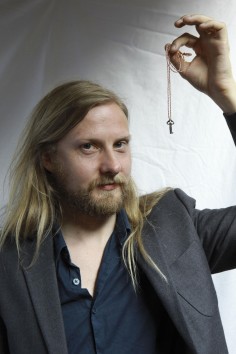
Movable feast
Punchdrunk's latest production takes place in a cavernous building where the audience's role is to keep up with the action, writes Andrew Dickson
It's an extraordinary location for a theatre production, but Punchdrunk's latest offering, , is no ordinary stage show.
The cavernous building next to London's Paddington station, a former sorting office, has been temporarily transformed to look like a full-scale Hollywood movie lot. The production, which runs from July 4 to the end of the year, is billed as the troupe's biggest and most daring yet: 200,000 square feet converted into what's tantamount to a performance playground for 600 people a night.
Masked and on their feet, audiences will be encouraged to assemble the story for themselves from clues deposited around the building: to nose down corridors, searching from space to space, following a cast of 34 as they seek the identity of a mysterious figure who meets a watery death.
Sitting inside a shabby storeroom that feels more like an interrogation cell, Punchdrunk artistic director Felix Barrett is rushing through the numbers: hundreds of crew, a hundred-plus performance spaces, three hours per night, 10 hours of continuous action if played end to end. "The budget of a small film," he says, then reconsiders. "Small-ish."
If that seems unimaginable for a piece of theatre, Punchdrunk has always flirted with the boundaries of impossibility. The London-based troupe's breakthrough piece, 2006's , took audiences inside an east London tobacco warehouse filled with eerily reimagined scenes from Goethe's play.
, the following year, was even more uncanny, occupying the entirety of Battersea Arts Centre for an atmospheric spin on Edgar Allan Poe's short stories.
Within this parallel dreamworld, we don't want the audience to get a grip on what's actually happening. It's all about illusion
The surreal and macabre have been constant themes, and, though Punchdrunk has many imitators, few do site-responsive work so well. "For us the whole point is the boundary between real and unreal. Within this parallel dreamworld, we don't want the audience to get a grip on what's actually happening. It's all about illusion," says Barrett.
Los Angeles' gimcrack glamour is both inspiration for and backdrop to . The plot, going on what the company has revealed, concerns a British-American film studio that might or might not be fictional, and which has closed in mysterious circumstances. Barrett is wary of giving away too much, but audiences will tumble through surreal scenes, jump-cutting from one illusory plotline to the next.
Partly inspired by Georg Buchner's enigmatic drama , the tale of a 19th-century German soldier who, brutalised by his experiences, butchers his unfaithful wife, Punchdrunk's new take - developed with co-director Maxine Doyle, who choreographs - sees the story played twice in parallel, in different sections of the building, with two teams of performers and the gender roles reversed.
"The play is so much about emotional danger and fragility," Doyle says. "What drives Woyzeck to commit such a crime of passion? I think it's present in all of us: how we can all be driven mad by jealousy or obsession."
Will anyone understand what's going on? Barrett nods. "If you know the play, you'll know who the leads are, and if you don't - well, you hopefully will by the end." They share a glance. "This time we might give people a synopsis, just in case."

Since 2009, the company has been regularly funded by Arts Council England, but has also achieved significant commercial clout: its twist on , called , opened in New York in 2011 and has been a huge success, numbering Natalie Portman and Justin Timberlake among its fans.
And, although its "enrichment" programmes for children and young people have been applauded - its -inspired adventure (2011) was a hit with eight-to-12-year-olds - the company has drawn fire for its partnerships with such megabrands as Sony and Stella Artois.
Barrett seems frustrated by the accusation that the company has sold out. "It's a time of sweeping cuts and, to try out new ideas, we can't always get the Arts Council to do that for us. If a brand gives us the money to try something new, it can become part of full-scale shows."
With tickets for costing up to £50 (HK$600) - 45,000 have already been sold - Barrett and Doyle are under pressure to live up to everyone's expectations, even though the happenstance nature of the work makes that far from straightforward. But they resist the suggestion that their brand of theatre is exclusive.
"It makes me sad if people come and have a bad time," says Doyle. "We try as hard as we can to make sure that doesn't happen." Barrett is more forthright: "The day we start spoonfeeding, it loses its impact. I know that from experience."
Punchdrunk has been around for 13 years: practically middle-aged, in theatrical terms. You can sense it's eager not to be pigeonholed as the company that does nothing but masks and funhouse murder mysteries.
"We've done six years of experimenting," says Barrett, "trying to see what excites us. There are six to eight projects that, if the stars aligned, we could press on with."
Any clues? "We're interested by what happens if you take away the building, what happens if the parameters shifted to a town or a whole city."
The mind boggles. Barrett laughs, and offers the Punchdrunk party line: "I'd love to tell you more, but if I gave it away …" But we can safely rule out the West End? Barrett sounds thoughtful. "You know, I'd love to do a musical. But I couldn't do it in a theatre. in a derelict building? on a cruise liner - would that work?"
